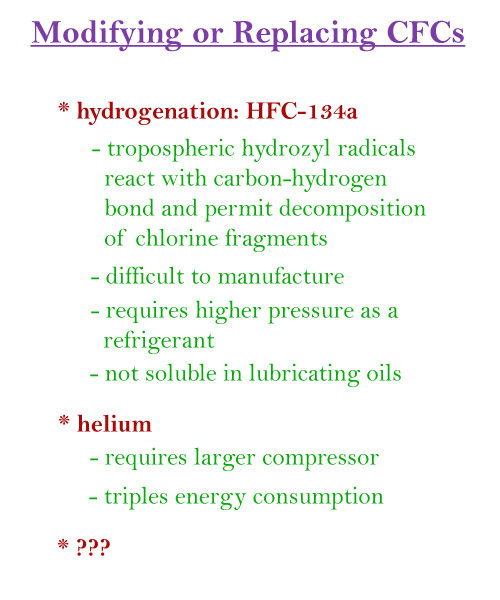
|
|
|
|
|
|
|
|
|
|
|
|
|
|
 |
|||||||
|
|
|
|
|
|
|
|
|
||
 Figure 1 - First published evidence of ozone
depletion. Rowland, 1989: American Scientist, 77, 36.
Permission granted by Sigma, Xi, The Scientific Research Society.
Figure 1 - First published evidence of ozone
depletion. Rowland, 1989: American Scientist, 77, 36.
Permission granted by Sigma, Xi, The Scientific Research Society.
 Figure 2 - Evidence of ozone depletion outside
Antarctica has not been easy to obtain. Rowland, 1989: American Scientist,
77, 36. Permission granted by Sigma, Xi, The Scientific Research Society.
Figure 2 - Evidence of ozone depletion outside
Antarctica has not been easy to obtain. Rowland, 1989: American Scientist,
77, 36. Permission granted by Sigma, Xi, The Scientific Research Society.
 Figure 3 -
South Pole Station, 1992 Ozone
Hole. E. Dutton, NOAA.
Figure 3 -
South Pole Station, 1992 Ozone
Hole. E. Dutton, NOAA.
 Figure 4 - CFC reaction equations.
Figure 4 - CFC reaction equations.
 Figure 5 - Distribution of Chlorine in the normal stratosphere.
Figure 5 - Distribution of Chlorine in the normal stratosphere.
 Figure 6 - Vertical distribution of
chlorine compounds in the atmosphere.
Figure 6 - Vertical distribution of
chlorine compounds in the atmosphere.
 Figure
7 - Stratospheric chemistry
(simplified). Takle, G.S., 2002
Figure
7 - Stratospheric chemistry
(simplified). Takle, G.S., 2002
 Figure
8 - Polar Stratospheric
Meteorology. Takle, G.S., 2002
Figure
8 - Polar Stratospheric
Meteorology. Takle, G.S., 2002
Figure 9 - Major Halocarbons: Statistics and
Uses. Sources: EPA, 1988a; Hammitt, et al., 1987; Wuebbles, 1983,; WMO, 1985.
 Figure 10 - Production of HFC-134a.
Source unknown.
Figure 10 - Production of HFC-134a.
Source unknown.
Related Class Images
 South Pole ozone hole September 4,
1991. Dutton, E., NOAA.
South Pole ozone hole September 4,
1991. Dutton, E., NOAA.
 South Pole ozone hole September 9,
1991. Dutton, E., NOAA.
South Pole ozone hole September 9,
1991. Dutton, E., NOAA.
 South Pole ozone hole September 27,
1991. Dutton, E., NOAA.
South Pole ozone hole September 27,
1991. Dutton, E., NOAA.
 Concentration of CFCs from
1978-1988. Houghton, J.T., G.J. Jenkins,
J.J. Ephraums, eds, 1990: 1990 Intergovernment Panel on Climate Change,
Cambridge University Press, 23-24.
Concentration of CFCs from
1978-1988. Houghton, J.T., G.J. Jenkins,
J.J. Ephraums, eds, 1990: 1990 Intergovernment Panel on Climate Change,
Cambridge University Press, 23-24.
 Vertical profile of the ozone
partial pressure observed by the SAGE II instrument on October 7, 1987. Source unknown.
Vertical profile of the ozone
partial pressure observed by the SAGE II instrument on October 7, 1987. Source unknown.
 CFCs - background. Takle, G.S., 1995
CFCs - background. Takle, G.S., 1995
 Modifying or replacing
CFCs. Takle, G.S., 1995
Modifying or replacing
CFCs. Takle, G.S., 1995
 Ozone production in
the stratosphere
Ozone production in
the stratosphere